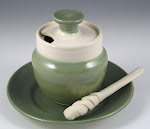When I do a show, it’s fun and very informative to meet other artists and crafters. At the JFS show May 6th, I met Susan James, who was showing and selling her beaded jewelry.
I learned that Susan’s business actually encompasses two
crafts. You can check out her jewelry and also the hats and capes that she
crochets, at www.design-site.net/headtotoe.
I have a hard enough time
pulling together one category of handmade objects. I interviewed Susan for this
blog to find out how and why she works with two.
Susan said, “I started
selling original design jewelry at the Aspen Saturday Market in 2001. It's a
long selling season--from mid-June to mid-October.”
She reflected on the seasonal
aspect of her sales. “When the weather got cool in September -- winter comes
early to the Rockies -- I noticed the customers were too bundled up or chilly
to try on jewelry, so my sales dropped."
"I needed a fashion accessory
product that could take me through the fall selling season in Aspen. Taught as
a girl by my grandmother to crochet, my primary experience had been making
afghan blankets for family and friends, and I hadn't crocheted in years. I
started experimenting with shaping hats, and after pulling out many errant rows
of crochet, I developed a line of hats for adults and children.” (Note: She also does capes. These are two of her customers:)
Impressed by Susan’s
perseverance, I wondered how she could make the hats pay off. I realized by her
answer that, at least to a certain degree, she thinks through who she is
selling to, before she even creates her inventory. She bases her analysis
partly on prior sales, but also on certain external factors.
“Over the years, three things
changed my hat-selling business. The first was global warming. In recent
seasons, Aspen stays hot until the middle of October. So I was selling winter
hats in hot weather for four months! The second was that certain styles sold
way better than others. And the third was the Great Recession, which caused
shoppers who used to buy colorful caps for every kid in the family and hats for
all the adults to pull back their purchases to perhaps one token hat as a
souvenir.”
So how did Susan adapt to
meet these challenges?
“This winter," she told me, "I designed a
new cotton fedora, which was instantly popular, and works well in warm weather
climates all year round. And I narrowed the collection to include only the few
top-selling styles. The warmest designs I only sell at a store in Aspen during
winter season. The cotton hats, flower headbands, and brimmed winter hats I
sell at my booth at farmers markets year-round.”
She added, “My biggest problem going
forward is that I've been crocheting for 6-8 hours a day for so many years,
that I've overused the muscle and nerve paths in my neck and shoulders, so now
I must limit my crochet to as few hours a week as possible, and sometimes avoid
it entirely. Thankfully, my jewelry design business has been growing, so the
hat business is supplementary and not primary at this point.”
As a potter, it was interesting for me to note this
challenge, to which I could relate. It is sometimes hard to live with the beating on the muscles, joints
and neural pathways, that comes from repetitive motion. I relate to it when my
wrists and lower back ache after working too long at the potter’s wheel. If the
problem gets bad, it requires that the crafter modify technique, or adjust to
making a less body-stressing product, like Susan did.
Making craft pay is quite a
challenge. Thanks, Susan, and hats off to you for sharing your experience.



I think we sometimes forget how physical making art can be. My own small experience with this were the cuts and scrapes I got making wire jewelry, but the impact on muscles and nerves from repeatedly making the same kind of art can be serious, and surprising.
ReplyDelete